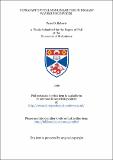Files in this item
Ultrafast optical nonlinearities in InGaAsP waveguide devices
Item metadata
| dc.contributor.advisor | Sibbett, Wilson | |
| dc.contributor.author | Roberts, Peter D. | |
| dc.coverage.spatial | 131 p. | en_US |
| dc.date.accessioned | 2018-06-07T11:21:57Z | |
| dc.date.available | 2018-06-07T11:21:57Z | |
| dc.date.issued | 1996-07 | |
| dc.identifier.uri | https://hdl.handle.net/10023/13806 | |
| dc.description.abstract | This thesis presents an investigation of the enhanced intensity-dependent refractive nonlinearity in optical amplifiers biased to transparency. Nonlinearities in an optical amplifier with a bulk active region and in optical amplifiers containing four, eight and sixteen quantum wells were compared using picosecond and femtosecond duration pulses generated using colour-centre lasers. Measurements of nonlinear absorptive and refractive dynamics in the amplifiers were performed using pump-probe and time-division interferometry techniques. A curve fitting function was used to distinguish nonlinearities from the measured dynamics. Carrier-heating, caused predominantly by free-carrier absorption, and virtual effects were found to be the most important nonlinearities in optical amplifiers biased to transparency. A strong correlation of the magnitude of the carrier-heating effect with the thickness of the amplifier active regions was observed. A novel measurement of the intensity dependence of the current required to bias optical amplifiers to transparency was performed using a technique which monitored the opto-electronic voltage across the amplifiers. The measurement showed that the transparency current increased linearly with intensity in the 4 QW and 8 QW amplifiers as a result of carrier-heating. Measurements performed on the 16 QW and bulk amplifiers showed a nonlinear variation of transparency current with intensity. These measurements were supplemented with a pump-probe investigation which revealed a negative trend in the transmission with a time constant in excess of 200 ps. It was suggested that a saturation effect related to the amount of heat added to the carrier distribution through free-carrier absorption was responsible for both of these effects. All-optical switching of picosecond pulses via the investigated enhanced nonlinearity was demonstrated in a polarisation switch, constructed using the bulk amplifier, and a nonlinear directional coupler. The optical powers required to perform optical switching were 1.6 W and 5.8 W respectively. | en_US |
| dc.language.iso | en | en_US |
| dc.publisher | University of St Andrews | |
| dc.subject.lcc | TK7871.3R72 | |
| dc.subject.lcsh | Lasers | |
| dc.title | Ultrafast optical nonlinearities in InGaAsP waveguide devices | en_US |
| dc.type | Thesis | en_US |
| dc.contributor.sponsor | SERC | en_US |
| dc.contributor.sponsor | British Telecom | en_US |
| dc.type.qualificationlevel | Doctoral | en_US |
| dc.type.qualificationname | PhD Doctor of Philosophy | en_US |
| dc.publisher.institution | The University of St Andrews | en_US |
This item appears in the following Collection(s)
Items in the St Andrews Research Repository are protected by copyright, with all rights reserved, unless otherwise indicated.

